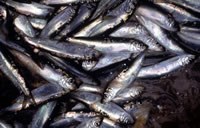 In 1994, Trustee Council-funded researchers studied a 40-year dataset compiled from trawl surveys to analyze the changing makeup of the north Gulf ecosystem. By meshing datasets from two different agencies, researchers identified a major shift in the types of prey available for many common predators. High-fat species such as capelin, sand lance, and eulachon declined sharply around 1978-80, while more lean fish such as flounder, pollock, and cod increased dramatically during this same period. Coincidentally, these studies were concurrent with measurements of atmospheric change being conducted by other scientists. This allowed the researchers to determine that this biological shift in the forage base coincided with a shift in atmospheric pressure and a two-degree Centigrade increase in the water temperature. This study documented an ecosystem-level effect from the "regime shift" in temperature and other factors, and linked it to the North Pacific Oscillation. While two degrees may not seem like very much, it has big effects, and it takes long-term data sets to find and quantify the significance of what would seem to be small changes.
In 1994, Trustee Council-funded researchers studied a 40-year dataset compiled from trawl surveys to analyze the changing makeup of the north Gulf ecosystem. By meshing datasets from two different agencies, researchers identified a major shift in the types of prey available for many common predators. High-fat species such as capelin, sand lance, and eulachon declined sharply around 1978-80, while more lean fish such as flounder, pollock, and cod increased dramatically during this same period. Coincidentally, these studies were concurrent with measurements of atmospheric change being conducted by other scientists. This allowed the researchers to determine that this biological shift in the forage base coincided with a shift in atmospheric pressure and a two-degree Centigrade increase in the water temperature. This study documented an ecosystem-level effect from the "regime shift" in temperature and other factors, and linked it to the North Pacific Oscillation. While two degrees may not seem like very much, it has big effects, and it takes long-term data sets to find and quantify the significance of what would seem to be small changes.
The change in the availability of quality forage fish may mean less growth and reproduction by the species that use these fish as their forage base. The impact becomes critical if the predator species are dependent on a particular forage fish, especially when trying to support the vulnerable phases in the life history of the predator species, such as juveniles. This ecosystem information provides essential context to the Trustee Council's efforts to restore resources impacted by the spill. It also contributes to a significant advancement of our understanding of oceanographic and atmospheric systems in the North Pacific.
